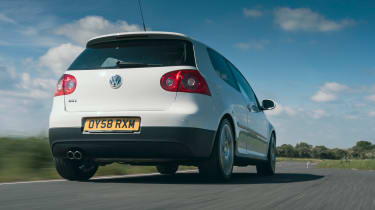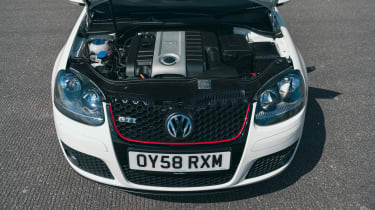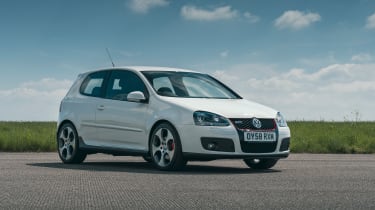Volkswagen Golf GTI (Mk5, 2004-2009): review, specs and buying guide
Volkswagen’s quintessential hot hatch saw a stunning return to form in Mk5 guise – here’s how to bag a used example today
The Mk5 Golf GTI was pivotal for the future of Volkswagen performance cars. Following the blunt, flat-footed Mk4, the GTI badge was in desperate need of a renaissance, and the Mk5 burst through the gloom in 2005 as one of the finest every-day performance cars of its time.
It captured the understated brilliance that defined the Mk1 and Mk2 before it; more exciting hot hatches have come and gone, but few blend seamless usability with honest, analogue fun quite as well as the Mk5 GTI.
The Golf nails the basics before you’ve even turned a wheel; the seat is mounted low and holds you firmly at the sides, the steering wheel extends far out to meet you and the golf ball gear knob falls perfectly to hand. Everything feels easy – mundane, even – at low speeds, and while it doesn’t provide the immediate gratification of a Mégane R26.R, there's depth to the GTI as you dig deeper into its abilities.
The EA113 turbocharged four pot feels organic and effervescent, delivering it's 197bhp with an enthusiasm that's missing from some modern day hot hatches. Sure, a modern diesel saloon would have no trouble keeping pace with a Mk5 today, but the Golf makes you work for its full potential rather than serving it on a plate. Thankfully, the gearshift – while not as tactile as a contemporary Civic Type R's – is free and light across the gate, making it easy to find a rhythm with the engine.
More reviews
The chassis is the star, though. Being softer-edged than some rivals of the period, there’s scope to hustle the Golf and really work all four tyres at road speeds, using weight transfer to bring the car alive and on its toes.
You can lean on it all the way through a corner with the inside rear tyre skimming the ground, at which point the GTI is energised and responsive to your inputs; adding throttle settles the rear, with a gentle lift pivoting the car around the apex. This isn’t a point-and-shoot hot hatch, but one where the driver can make a difference; and that certainly couldn’t be said for the Mk4.
Buying checkpoints
The Mk5 has also proved to be reliable nearly two decades since its launch, but as ever with an older performance car, mechanical niggles can emerge through years of use and abuse. Andy McLeish is one of the technical gurus at APS in Brackley; VW-trained, he has decades of experience and takes us through some of the points to look for. ‘Generally, the Mk5 GTI is a pretty bulletproof car,’ he says, ‘but there are a few areas to check.’
Engine
While the GTI’s engine is excellent, it is also inherently noisy. Beyond the mechanical thrash, there are one or two sounds to listen out for – one of which is a rattle that disappears soon after start-up but reappears a couple of miles later, which could indicate a problem with the camshaft-driven fuel pump.
The turbo’s diverter valve (dump valve) uses an electronically controlled rubber diaphragm to dump charge air back into the intake system. The diaphragm can split, though, leading to a loss of boost and a fault light on the dashboard.
The engine cover houses the air filter and it can be a pain to remove, leading to broken covers. While this doesn’t cause problems, a replacement cover can be expensive.
Coil packs tend to fail in groups, so a misfire could be a telltale that the packs are on their way out.
Changing the timing belt can be awkward, as the exhaust downpipe has to be removed to get access. If the bolts come out with no trouble, then it’s a straightforward job; if not, they need drilling out. APS recommends changing the water pump and thermostat at the same time (every 70,000 miles or four years).
APS also strongly recommends an oil change every year or 10,000 miles to prevent the oil from degenerating and causing problems.
Transmission
The six-speed manual transmission shouldn’t give you any worries. However, a heavy clutch indicates that a replacement is due.
The DSG gearbox should be smooth and effortless, but a complete service history is crucial. If it hasn’t been looked after properly, it can hang on to gears, hunt around and give very jerky changes. ‘Anything wrong will be expensive to remedy,’ warns Andy.
Suspension
The Mk5 can suffer from uneven tyre wear, particularly at the rear because of the amount of suspension adjustment available. If the rear camber and toe angles are incorrect, the inner edges of the tyres will wear far faster than the centre sections or outer edges, which could necessitate new rubber. The rear bushes on the front wishbones can become weak, too, which can lead to the caster angle changing and feathering on the inside of the tyres.
There have also been issues with rear springs breaking, so check for an uneven stance. This is not a disaster, though, as springs are readily available and a straightforward repair.
Chassis and bodywork
As with other Volkswagens of the period, the body is very well put together. Just make the usual checks for consistent panel gaps and paint colour to ensure the car hasn’t been pranged.
Interior
The interior is well built and uses quality materials, but make sure the condition matches the mileage.
‘Air conditioning compressors can fail,’ warns Andy, ‘so always check the air con works. If it doesn’t, it could be a high-pressure switch or it could be the compressor – originals can be expensive.’
What to pay
Plentiful supply means that the used market is highly competitive, and it’s possible to bag a Mk5 GTI with sensible mileage for as little as £7000 – or around half as much as a brand new Volkswagen up!...
Speaking of mileage, given how usable and untaxing the Mk5 is to drive, there are hordes of leggy examples out there – and the best-kept cars tend to stand out. Sub-50,000 mile GTIs cost upwards of £8500, with clean Edition 30 models – built to celebrate thirty years of the GTI badge and packing an uprated 227bhp engine – priced beyond ten grand. There’s a roughly equal selection of DSG and manual options to choose from, so you’re likely to secure the right car whatever your preference.
'I bought one'
Edward Belshaw - Edward has owned a 2006 Mk5 GTI for a year now, but finding his perfect car in a crowded used market took time. ‘I wanted a hot hatch and tried to test-drive all the likely candidates, like the Astra VXR and the Focus ST, but as a 22-year-old walking into dealerships I got nowhere.’
‘I eventually tried two manual GTIs and realised that it was the Golf I wanted, but I was also keen to try one with the DSG gearbox before making my decision. I saw this car advertised, went to drive it and that was it: sold.
‘The addition of DSG makes the car so flexible; you can drive in traffic or cruise and feel fine at the end of a five-hour drive – while getting 40mpg. But if you want to have some fun, it’s fantastic. The engine pulls really well, the gearchanges are unbelievably quick and smooth, and the whole experience is incredibly rewarding.
‘I haven’t had any problems with my GTI and I’d buy another one without thinking – in fact, I probably will.’
Volkswagen Golf GTI Mk5 specs
| Engine | 2-litre turbocharged 4cyl |
| Power | 197bhp |
| Torque | 207lb ft |
| Weight | 1328kg |
| Power-to-weight | 148bhp/ton |
| 0-62mph | 7.2sec |
| Top speed | 146mph |
| Price new | £19,995 |
| Value today | from £7000 |










